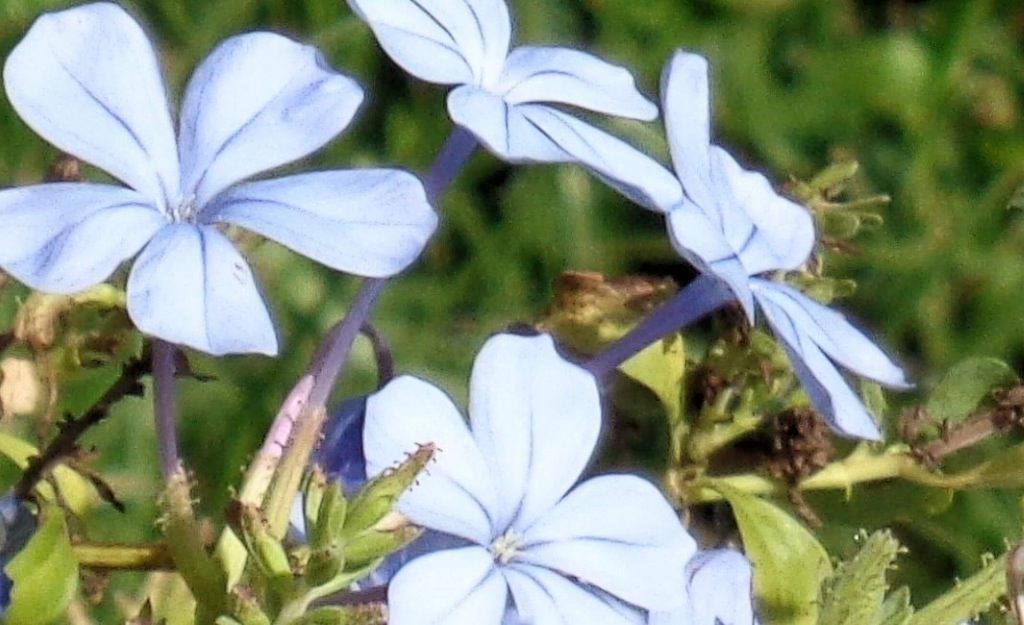 Several years back, we had a terrible outbreak of chilli thrips across the state which really did a number on plants such as plumbago. Their easy-to-care-for nature became labor-intensive and many failed in the landscape or were no longer ornamentally useful and were discarded. While chilli thrips are still around, their damaging nature seems to have subsided into the background. Likely, parasites and/or predators have knocked down the population and suppressed the damage. As such, I would encourage gardeners to replant these sky-blue-flowered beauties back in the landscape.
Several years back, we had a terrible outbreak of chilli thrips across the state which really did a number on plants such as plumbago. Their easy-to-care-for nature became labor-intensive and many failed in the landscape or were no longer ornamentally useful and were discarded. While chilli thrips are still around, their damaging nature seems to have subsided into the background. Likely, parasites and/or predators have knocked down the population and suppressed the damage. As such, I would encourage gardeners to replant these sky-blue-flowered beauties back in the landscape.
Native to South Africa, the plumbago is a good-sized, sprawling, fast growing evergreen shrub known for its mounds of pale blue flowers; a shade of blue not produced by many other local flowers. This shrub can flower year round with most flowers produced spring through fall. At a glance, the clusters of blue flowers will remind you of phlox flowers. Great in foundation plantings or in containers, plumbago make the biggest splash where their limber branches can cascade over a retaining wall. Plant four to six feet apart in mass plantings or as a colorful groundcover. As long as you plant plumbago in full sun and well-drained soil, they are not overly fussy about soil conditions. Once established they are very drought-tolerate. In our high pH soils, plumbago leaves may tend to yellow due to certain nutrients being biologically locked up in the soils, so fertilize accordingly.
Plumbago shrubs can grow up past six feet tall and wide, so occasional selective pruning will keep them in bounds. Do not over-prune during the growing season as this will often reduce flower production. To promote new growth, prune this shrub relatively heavy in late winter around March. Although hardy in our area, frosts or freezes can nip plumbago back a bit as well. Even if it were frozen back to the ground, the plumbago will more often than not, grow back without a problem.
While one named variety called ‘Imperial Blue’ is abundantly available, there is also a cultivar called ‘Royal Cape’ with cobalt blue flowers. For something completely different, the white-flowering cultivar ‘Alba’, can provide a refreshing change within your plant palette.
While plumbago have very few pests, the previously mentioned insect known as chili thrips entered Florida in 2005 and had really taken a liking to many formerly low maintenance plants such as plumbago. Chilli thrips-infested plumbago almost looked like they had a fungal disease due to the numerous blackened leaves. The good news is that this insect problem seems to have abated and has leveled off in our area as natural predators have built up to suppress chili thrips to a point where damage is minimal to none. One additional item to note is that plumbago have what are called chalk glands on the underside of their leaves. This white deposit is natural and should not be confused with a fungus or other pest – just a normal abnormality!
Consider plumbago, a true Florida-Friendly Landscaping™ recommended plant, in your landscape for color and eye-appeal.
Just as a reminder, we are moved to our new office at the North Charlotte Regional Park at 1120 O’Donnell Blvd, Port Charlotte FL 33953.. Our phone numbers and email addresses will remain the same. Our Eastport Environmental Demonstration Garden will continue to be open to the public outside the gate at 25550 Harbor View Road. You can continue to call our Master Gardener volunteers on the Plant Lifeline on Mondays, Wednesdays and Fridays from 1 to 4 pm at 764-4340 for gardening help and insight into their role as an Extension volunteer through the first of the new year. Don’t forget to visit our other County Plant Clinics in the area. Please check this link for a complete list of site locations, dates and times – https://sfyl.ifas.ufl.edu/media/sfylifasufledu/charlotte/docs/pdf/Plant-Clinics-Schedule1.pdf. I thank you for your continued support of Extension during this transitional time. Ralph E. Mitchell is the Director/Horticulture Agent for the UF/IFAS Charlotte County Extension Service. He can be reached at 941-764-4344 or ralph.mitchell@charlottecountyfl.gov.
Resources:
Gilman, E. F. (2014) Plumbago auriculata Plumbago, Cape Plumbago, Sky Flower. The University of Florida Extension Service, IFAS.
Warner , K.(2017) Q: Why is my plumbago shrub not doing well? The University of Florida Extension Service, IFAS – Nassau County.
Landre, C. (2019) Blue Plumbago. https://www.south-florida-plant-guide.com/blue-plumbago.html
Ferrer, A. (2014) Plumbago. The University of Florida Extension Service, IFAS – Seminole County
Caldwell, D. (2006) Chili Thrips: New Thrips Found on Plumbago: Could Mean Serious Losses for Ornamentals and Veggie-Fruit Industries. The University of Florida Extension Service, IFAS – Collier County.
The Florida-Friendly Landscaping™ Guide to Plant Selection & Landscape Design (2010) The University of Florida Extension Service, IFAS.
 1
1
